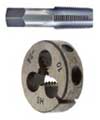
Sheet Metal 101
|
Sheet Metal
Sheet metal comes in many different thicknesses, commonly referred to as the gauge. There are several standards to determine the gauge, this site explains them and includes a gauge calculator. The same gauges of brass, aluminum or steel will all be of different thicknesses due to the fact that the gauge is based on the weight of the metal, ShopDawg.com has a handy chart here. I have listed common sources for the various types that I have discovered that are usually less expensive than purchasing from a hobby shop. Aluminium (UK) or Aluminum (US) Aluminium is a soft, durable, lightweight, malleable metal with appearance ranging from silvery to dull grey, depending on the surface roughness. Aluminium is nonmagnetic and nonsparking. Corrosion resistance can be excellent due to a thin surface layer of aluminium oxide that forms when the metal is exposed to air, effectively preventing further oxidation. It may be welded with the appropriate type of wire or rod. Available at building supply outlets as flashing. Brass Brass is any alloy of copper and zinc; the proportions of zinc and copper can be varied to create a range of brasses with varying properties. It has a muted yellow color, somewhat similar to gold and is relatively resistant to tarnishing. Brass may be brazed or soldered. May be obtained from auto supply outlets as shim stock. Copper Pure copper is rather soft and malleable, and a freshly-exposed surface has a pinkish or peachy color. It does not react with water, but it slowly reacts with atmospheric oxygen forming a layer of brown-black copper oxide, a green layer of copper carbonate, called verdigris, can often be seen on old copper. Copper is generally soldered. If you are lucky building supply outlets will carry it. Steel Often incorrectly referred to as "tin", steel is one of the most common types of sheet metal. It may be welded, brazed, or soldered. It is subject to rust if left unprotected and often will have a galvanized coating if it is used in a situation that does not require painting. Galvanized sheets are available at building suppy outlets, bare metal may be obtained at auto supply outlets. This chart will give you a basic idea of the thickness of steel sheet metal.
Soldering, Brazing or Welding Soldering and brazing are essentially the same, the only differences are the filler metals used and the amount of time and heat required to complete the joint. Soldering is a joining process that takes place below 840 degrees F, while brazing takes place above 840 degrees F. In actual practice for copper systems, most soldering is done at temperatures from about 450 degrees F to 600 degrees F, while most brazing is done at temperatures from 1,100 degrees F to 1,500 degrees F. Brazing is generally a stronger joint than solder, however when brazing copper tube the annealing of the tube and fitting that results from the higher heat can cause the rated pressure of the system to be less than that of a soldered joint. Brazing is done with either a silver based filler, hard solder or silver solder, or a bronze rod depending on the material being joined. An advantage of brazing over welding is that two dissimilar metals may be joined together. Welding is a process for joining similar metals by melting and fusing, employing pinpointed, localized heat input and a filler material. Welding covers a temperature range of 1500º F - 3000º F . Weld joints are usually stronger or as strong as the metals being joined. |

